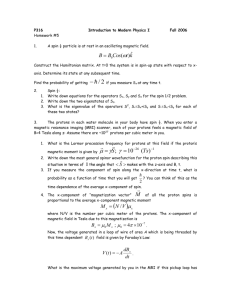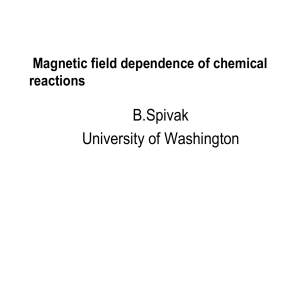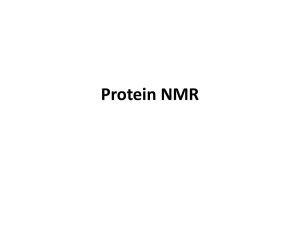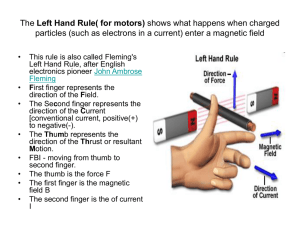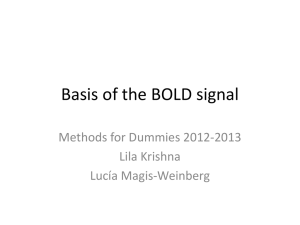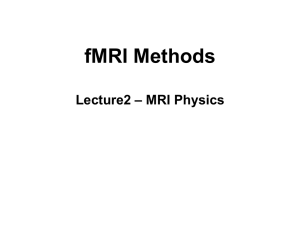MRI Background
advertisement
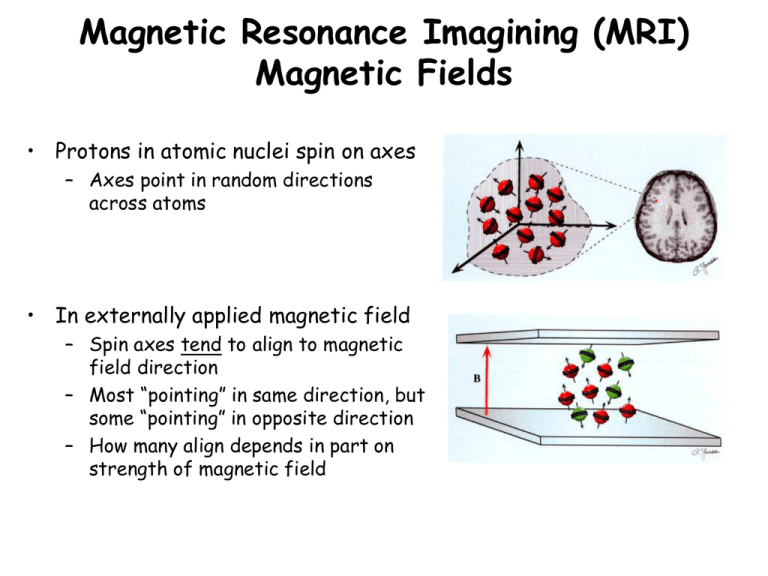
Magnetic Resonance Imagining (MRI) Magnetic Fields • Protons in atomic nuclei spin on axes – Axes point in random directions across atoms • In externally applied magnetic field – Spin axes tend to align to magnetic field direction – Most “pointing” in same direction, but some “pointing” in opposite direction – How many align depends in part on strength of magnetic field MRI Magnetic Fields Cont’d • In an externally applied magnetic field, atomic nuclei with an odd number of nucleons (protons + neutrons) precess – = Spin axis wobbles – Rate determined both by properties of the atom – And by the strength & homogeneity of the magnetic field – Hydrogen atoms in a 1.5 Tesla field precess at ~64 MHz = Radio frequency [rf] – Timing (phase) of wobble still random across atoms Resonance • A radio frequency pulse (rf pulse) of a particular frequency is applied to the aligned protons in the magnetic field – When rf pulse frequency = precession frequency = Larmor frequency, nuclei resonate to it – Pushes spinning protons into phase with one another – Amplitude of wobble of the whole magnetic field generated by the spinning protons increases (= spin axis is pushed farther out) • Increases “transverse component” of magnetic field • Which is what’s measured – How far spin axis moves (= flip angle) depends on rf pulse intensity and duration Why is this useful? • Takes characteristic amount of time after rf pulse for protons: – To get back out of phase (= de-phase) – And to settle back to original wobble amplitude in fixed field – Depending on what other kinds of atoms are nearby • i.e, the kinds of molecules the atoms are in, in part • As protons settle back into alignment with fixed field, the strength of the magnetic field they generated decreases – Variations in how long it takes the protons to de-phase & to settle back to original wobble amplitude in fixed field – Can be used to distinguish among different substances How does this make IMAGING possible? • How know where magnetic field being measured comes from?) • Use gradient magnetic fields (Lauterbur Nobel Prize) – Generate field with gradation in field strength with only a small region at 1.5 Tesla – Only hydrogen atoms within that region respond to 64 MHz pulse – So, response must come from protons within 1.5 T region – Keep moving position of 1.5 T area to localize source of responses to repeated rf pulses – Size of 1.5 T region determines granularity of localization of response Siemens Allegra 3T Biomedical Imaging Center (BIC) Fixed field magnet is (almost) always on! - Child killed in 2001 at Westchester Medical Center when an oxygen tank brought into magnet room was pulled into center of magnetic field - In 2000, police officer’s gun pulled from his hand into magnet & discharged a bullet into the wall on the way in Structural MRI • Anatomical scans generally measure hydrogen atoms in water – Since different kinds of tissue have different proportions of water • Typical anatomical scan voxel granularity = 1 x 1 x 3-5 mm Functional MRI (fMRI) • Substance measured is hemoglobin (iron) in blood – Blood flow increases to active brain regions – Increases more than is usually needed – So ratio of de-oxygenated to oxygenated blood decreases • Oxygenated & de-oxygenated hemoglobin respond differently to magnetic field and rf pulses – Use this to detect where more oxygenated blood goes after some event – Takes several seconds for the response to peak • Timing seems to vary some across different brain regions – Fastest reliably detectable pre-peak response so far = 2 - 4 sec – Signal strength change very small – generally less than 1% change • If signal strength large, probably due to draining vein Important to avoid measuring this instead of this fMRI Cont’d • Spatial resolution: – Ultimate limit probably spatial specificity of the circulatory system – Worse than structural MRI – Typical functional scan voxels = 3 x 3 x 5 mm • Temporal resolution: – IF blood flow is what’s measured, never going to be faster than seconds – Working on detecting the brief initial decrease in oxygenated blood preceding increased blood flow – Working on imaging other substances fMRI Data Analysis • Much of the brain is active much of the time – (e.g., “default network”) • Try to isolate regions that are specific to some aspect of the event of interest – One widely used approach is to look for voxels whose time course of signal strength change after stimulus is correlated with an idealized hemodynamic response function – Decide on a threshold for correlation strength and only further analyze voxels exceeding that threshold Subractive Logic - Construct 2 conditions that you believe differ in just 1 important way - Treat one as baseline & subtract it from the other to get rid of all the activity the 2 have in common - And then analyze what’s left - May only analyze part of what’s left because may threshold (again), and/or may only analyze Regions of Interest (ROI) - These are all ways to cut down the number of statistical comparisons done Subtractive Logic, Cont’d • Similar logic used in comparing conditions in most other kinds of experiments, too • But there’s been a very unfortunate tendency in much of the imaging literature so far, • For researchers who don’t have a good understanding of the many ways that different kinds of stimuli and/or tasks and/or situations can differ, • To claim that they’ve located “phonological word processing”, or “irregular morphological inflection processing”, or some such aspect of language processing • When other confounded differences between conditions are equally good candidates (such as plain old difficulty) for explaining the effects


